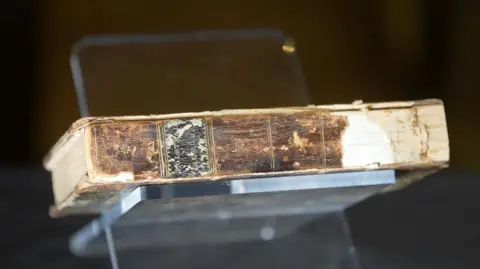A remarkable discovery at the Moyse’s Hall Museum in Bury St Edmunds has unearthed a chilling piece of history – a book bound with skin from 19th-century murderer William Corder. The discovery, made recently within an office space, has captivated researchers and historians alike, offering a visceral connection to one of Suffolk’s most infamous crimes: the Red Barn Murder.
The story begins in 1827 when William Corder, a middle-class tenant farmer from Polstead between Ipswich and Sudbury, brutally murdered Maria Marten. The crime shocked Georgian Britain and became known as the ‘Red Barn Murder’ due to its gruesome details. Maria, aged 24 and living with her father, stepmother, sister, and young son, had been lured to the Corder family farm under false pretenses. It is believed she was tragically shot in the neck.
Following the murder, William Corder initially fled Suffolk, writing a letter to Maria’s family claiming he had eloped with her to the Isle of Wight. However, investigators soon discovered that he was hiding just outside London, and Maria’s body was found buried at the lovers’ rendezvous point. A manhunt ensued, culminating in his arrest after a newspaper editor recognized him based on an advertisement he placed seeking a new wife – revealing his loneliness and desperation.
The ensuing trial in 1828 was a dramatic event, with Corder facing ten counts of murder, each representing a different theory surrounding Maria’s demise. In a final confession, he claimed that Maria had killed herself, effectively accusing her of capital crime. Despite this defense, the jury found him guilty and sentenced him to death. On August 11, 1828, Corder was hanged outside the prison at Bury St Edmunds before an estimated crowd of 7,000 to 10,000 spectators; a temporary scaffold had to be erected due to overcrowding.
The spectacle drew considerable attention and spawned souvenirs, including sections of the rope used in his execution. Furthermore, Polstead became a tourist destination as people flocked to witness the site of the crime and visit Maria’s grave, which was sadly damaged by souvenir hunters. The gruesome details of the case continue to fascinate and are still explored in true crime literature today.
The book discovered at the museum is particularly unsettling – it’s cover and corners were crafted using the skin of William Corder himself. This artifact, along with a death mask created from his skull, are now part of the Moyse’s Hall Museum collection, alongside remnants of his skeleton which was once used for medical training.
Interestingly, Terry Deary, author of the ‘Horrible Histories’ series, believes Corder has been unfairly portrayed in history. The museum is planning an upcoming exhibition that will shift the focus to other female victims of crime within Suffolk’s history, including Maria Marten. Heritage assistant Abbie Smith reports that 80% of visitors express a keen interest in learning more about the Red Barn Murder, demonstrating its enduring power and morbid appeal – a testament to this dark chapter in Suffolk’s past.

